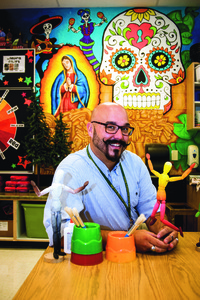

Steven Cregger in his colorful classroom. (photo by David Grace)
When you walk into Steven Cregger’s art classroom at High Point Elementary School, you’ll find yourself surrounded by colors and energy.
The walls are covered with colorful murals of scenes from around the world, including Egypt, Russia, China and more. The scenes are populated with interesting characters, such as Mickey Mouse.
Cregger is a self-described “big kid†who enjoys teaching art to children.
“I love teaching art because not every kid gets a chance to feel successful. Reading is hard for some, or they don’t like it, or math is hard for some. There’s not a right or a wrong answer in art class. There’s no multiple-choice question where the only answer is C. I’ve had six-legged elephants, butterflies with impossible wings, cats with two heads, all of which are fine. There isn’t room for creativity or artistic license in algebra, and kids and adults need an outlet where we don’t have to follow a set of rules (except for not cutting their hair with scissors or eating glue sticks). We all need a little freedom,†Cregger says.
His students’ artwork decorates the school’s hallways. Cregger has clotheslines to hold the artwork and also uses other teachers’ cork strips and bulletin boards. “When students see their artwork in the hall, they show it to their friends and their family. That pride and self-esteem is important because school is hard.â€
He says that he became a teacher rather than pursuing painting because “I’m a little all over the place. I’m a painter first, but I like so much more than that, especially clay and making jewelry. I couldn’t do just one thing, and I love kids. I’m just a big kid and that’s why I get along so well with them.
“Every 40 minutes I get a new, fresh crop. After 40 minutes and a project, I’ll get to do it again with a new class. I’ll move from painting to clay and then paper mâché. I like teaching that way. If I’m bored teaching something, I know they’re bored learning about it. I keep everything fun. We tell jokes and dance.â€
In addition to making sure that his students enjoy learning about art, he connects his art to the other subjects his students are taking.
“In third grade they do a huge social studies unit about world cultures. For Egypt, they learn about pyramids, how they were built and more. I give them the opportunity to make a sarcophagus and a mummy and the symbols on the outside. I think the hands-on learning works so much better than a worksheet. Giving them a concrete object to relate to a concept helps. Also, when they see this project 10 years down the road, they can look back and remember what they learned.
“For fourth grade Virginia history, we made little Jamestown houses. Language arts is pretty easy. I read them a story and give them just the words, and they have to illustrate that page. That’s hard for them because they want to draw every character, not just what that one page is about. So editing is hard for them.
“In the other classrooms it’s rigorous, and kids are pushed hard. That’s good. They need to learn a work ethic. In here they don’t feel that pressure. So, when I teach Egypt, it’s a little more engaging than the classroom style of teaching. I think most people learn better hands-on,†he says.
One of his fifth grade projects combines social studies and math. “I never dreamed this math project would turn into one of their favorites. In fifth grade, they’re getting a little older and can handle more difficult projects. They study Native Americans, so we talk about dream catchers. That’s the Native American part. The math part is radial symmetry (symmetry around a central axis). They get a bulls eye to start with and whatever they do on one stick, has to be done on another stick, etc. They use the principles of radial symmetry to create their dream catcher,†Cregger says.
His projects require a lot of preparation, such as creating all the clay pieces that his students use to create a clay castle. Cregger works on this preparation during his planning period, after school and on Saturdays.
“It doesn’t bother me. I doubt accounting is an accountant’s hobby as well as their profession, but art is mine. It’s not work if you love it.
“Teachers always wonder if we’ve really made an impression. I work with John S. Battle and Abingdon High School marching bands. Now that I’ve been at this a while, there are kids in band who come up and say ‘Do you remember when we made those clay castles? I still have mine. I looked at it this morning.’ Leaving a little piece of me with them, that’s what means the most. That they remember these little things we made in class and that they feel good about it,†he says.
He recently gave some advice to a friend who’s working with elementary band students. “You have to be more interesting than a smartphone, tablet, iPad or video game. You have to be just as engaging as a tablet. My goal is to be an iPad with the coolest apps possible, even if it’s an app you have to pay for.â€
THERE'S MORE
> Steven Cregger’s art is on display at school